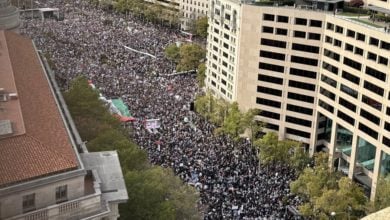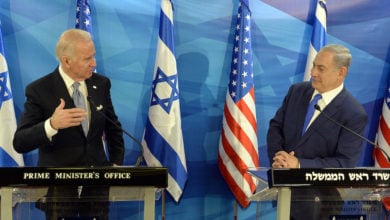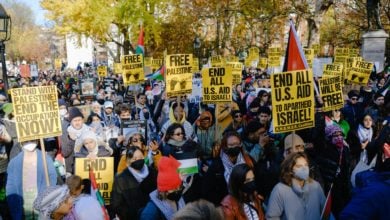Photo credit: Ricardo Figueroa / Flickr
Puerto Rico is still reeling from the devastation left in the wake of Hurricane Fiona, which hit the island on September 18 bringing with it historic flooding and landslides. At least a dozen people have died and thousands more required emergency rescue. Fiona’s arrival came only two days before the 5-year anniversary of superstorm Hurricane Maria which pummeled Puerto Rico in 2017, killing over 4,000 people and leaving millions more without power — some for up to a year. Five years later, the island is once again in darkness and Puerto Ricans are left to fend for themselves. Here are five things you should know about hurricanes in Puerto Rico and why this keeps happening.
- Puerto Rico is one of the oldest colonies in the world
Originally inhabited by the Taínos and known as Boríken, the island was invaded by the Spanish 529 years ago during Columbus’ second voyage. Later, the United States would seize control of it in 1898 as an imperialist spoil of the Spanish-American War. Today, over a hundred years have passed since its forced annexation, yet Puerto Rico remains in a state of legal limbo and Puerto Ricans have second class citizenship. Puerto Ricans have essentially no control over their economy, they are unable to vote for president or Congress, and yet are forced to live under U.S. laws.
Puerto Rico has a poverty rate of 43.5%, surpassing that of Mississippi, the poorest U.S. state. As a result, millions of Puerto Ricans have been forcefully displaced throughout the decades — some 200,000 of whom were forced to evacuate the island as a direct result of Hurricane Maria in 2017. Puerto Rico’s colonial status doesn’t just exacerbate the island’s myriad social and economic issues, it is the root cause of them.
The underdevelopment that centuries of colonialism has caused makes Puerto Rico increasingly vulnerable to natural catastrophes. Hurricanes are an inevitable reality for many Caribbean islands, but their imminence means that local governments and federal disaster relief agencies like FEMA should be able to plan for them accordingly. In Puerto Rico, hurricanes have a habit of unmasking Washington’s refusal to do so, and thus the dire reality of colonialism on the island.
- Hurricanes in Puerto Rico are inevitable, disaster colonialism is not
Five years ago on September 20, 2017, Hurricane Maria hit Puerto Rico. It was a Category 5 storm — the strongest to impact the island in nearly 90 years — and it left unimaginable damage in its wake. While Puerto Ricans went months without power, water or adequate shelter as a result, then President Donald Trump lied about the death toll on his Twitter account, claiming that between 6 to18 people had passed away. In reality, over 4,000 Puerto Ricans died in the aftermath of Maria. Most were not victims of the storm itself, but of the gross government neglect that Puerto Rico experienced afterward as FEMA and the White House dragged their feet to deliver vital aid.
Long after the storm subsided, the number of fatalities continued to rise as a result of solvable, secondary issues. Take for example, the 26 post-Maria deaths attributed to Leptospirosis, a potentially fatal bacterial infection that spread through the island as survivors were forced to drink fluids containing rodent waste in the absence of clean drinking water. Some two years after Maria, tens of thousands of water bottles issued by FEMA were found abandoned in fields, unopened and expired, never having been distributed to those that so desperately needed them.
Despite such blatant unpreparedness for Maria, the Puerto Rican colonial government has done little to prepare for the next storm in the five years since. Repairs to damaged homes and infrastructure across the island were slated to begin in 2017, yet today, thousands of homes and roads have yet to be fixed. The government has completed only 21% of more than 5,500 planned repair projects and much of what was completed was done poorly. When Fiona hit on Sunday, upwards of 3,600 homes on the island still did not have roofs. In Utuado, a municipality in the central region of the island, viral video footage showed a bridge rebuilt after Hurricane Maria being swept away by aggressive flood waters.
The arrival of Fiona has put even more strain on this already weakened infrastructure. The storm dropped record amounts of rain and caused catastrophic flooding. Early on Sunday, 100% of the island experienced power outages. With no power, people are forced to rely on cumbersome and unreliable backup generators that require expensive diesel fuel to operate, making them inaccessible to many. After Maria, some municipalities went for an entire year without power. This time, Governor Pedro Pierluisi has publicly admitted that thousands will again have to endure “several days” without power. From experience, Puerto Ricans know that “several days” can easily turn into months. Currently, nearly half of the island is still without electricity.
Compare these abysmal relief efforts to the hurricane responses of another Caribbean country, Cuba. In 1959, Cuba waged a successful revolution against imperialist forces on the island, putting an end to the legacy of colonialism that had historically underdeveloped the nation. Shortly thereafter in 1966, the revolutionary government established a civil defense system that became a global model for disaster relief efforts. Today, disaster preparation and response in Cuba saves lives. In 2004 for example, Hurricane Jeanne killed 3,000 people in Haiti, but none in Cuba, even though Cuba was hit harder. A 2004 United Nations press release praises the island as a leader in disaster preparedness despite the U.S.-imposed blockade that makes it difficult for them to obtain emergency disaster supplies. A side by side comparison of Cuba and Puerto Rico’s hurricane track record makes it clear that it is a capitalist response to disasters, not the disasters themselves, that pose the real problem.
- U.S. corporations profit off disasters and privatization in Puerto Rico
Why does this pattern of disregard exist and what motive does the United States have to continuously fumble repair efforts and delay assistance? Simply put, the U.S. ruling class profits from disasters in Puerto Rico. After Hurricane Maria, PREPA, Puerto Rico’s government-owned utility system, awarded $4.4 billion in contracts to corporations for services related to hurricane reconstruction and necessary repair work to the electrical grid. A whopping $3.7 billion of those contracts went to U.S.-owned private companies.
PREPA and the Puerto Rican government are notorious for favoring private companies over local workers and unions. UTIER is the labor union that represents PREPA workers and is one of the leading forces in the fight against the privatization of Puerto Rico’s grid. According to union leaders, in one case, PREPA paid a Florida-based corporation to repair street lights in Puerto Rico at a rate of over $400 per unit, even though local union workers offered to do the same work for only around $60.
This trend extends beyond contracts awarded by PREPA. FEMA, for example, awarded $156 million to Tribute Contracting LLC, a one-person company based out of Atlanta who promised to deliver 30 million emergency meals to survivors of Maria. Only 50,000 of those meals — less than 0.2 percent — were ever delivered. Such corruption plagues relief efforts in Puerto Rico — purposeful mismanagement funnels life-saving aid out of the island and into U.S. corporate accounts.
Unsurprisingly, the United States’ relationship with Puerto Rico has always been one based on extraction of profit. U.S. corporations squeeze billions of dollars from the island annually. Yet, mind bogglingly, Puerto Rico owes a staggering $72 billion in debt to Washington. In June of 2016, President Barack Obama signed PROMESA, Puerto Rico Oversight, Management, and Economic Stability Act, into law, which established a Fiscal Oversight Board colloquially known as “La Junta.” Tasked with overseeing the repayment of the island’s debt, La Junta itself is largely a foreign body — its members are chosen by the U.S. president and Congress and are unaccountable to Puerto Rican residents.
Many of the board members have ties to multinational corporations and have increased a push towards privatization on the island as a way to line the pockets of foreign creditors. With leeway to make sweeping executive changes to the island’s economy, La Junta has established an austerity regime in Puerto Rico, systematically cutting funding for vital public services in order to pay the colonial piper.
The privatization of PREPA is a prime example. On June 22, 2021, despite Puerto Rico’s House of Representatives voting unanimously against the contract, La Junta announced that LUMA would assume control of the formerly public electrical grid. The announcement was met with sustained outcry from Puerto Ricans, who were kept in the dark regarding contract negotiations. LUMA, an American and Canadian owned utility company, laid off hundreds of UTIER workers, refusing to honor their contracts and agreeing only to interview workers should they decide to reapply. As a stipulation, any workers who were rehired would have to relinquish their pensions and other benefits. Many of the workers — most of whom had years of experience as linemen on the grid — declined these arrangements, resulting in a dangerous labor shortage leading up to hurricane season.
To justify layoffs, Puerto Rico’s government argued that LUMA would modernize the island’s electrical grid and make the cost of electricity more affordable for residents. In reality, PREPA’s privatization was a way to outsource service and boost profits. Even in the absence of storms like Fiona, outages in Puerto Rico have been frequent and long lasting since LUMA took over. Utility bills for individuals have also skyrocketed.
LUMA’s response to the public outrage, like that of Governor Pierluisi, has been entirely dismissive. In June, for example, the corporation held a press conference to address the constant blackouts. Reprehensibly, they conducted it entirely in English, refusing to provide translation services and effectively ostracizing over 75 percent of the island’s population who do not speak English. In a statement after the fact, LUMA’s CEO Wayne Stensby minimized the incident, insisting that English is one of the island’s official languages. Pierluisi and his cohort have come under scrutiny for colluding with colonizers like Stensby, prioritizing the interests of foreigner corporations over the lives of Puerto Ricans themselves.
Notably, in light of Fiona, a number of former PREPA workers have volunteered their expertise to perform the grid repair work that would restore electric service to those who are still without it. Pierluisi has said he will consider their offer, but has yet to accept their help. Meanwhile, these skilled electrical workers continue to perform unrelated labor while blackouts drag on.
- In the wake of hurricanes, Puerto Ricans get pushed out
While the logical humanitarian response to hurricanes should be rapid relief for the most vulnerable, in Puerto Rico post-hurricane vulnerability has been exploited for the benefit of the rich. After María, two different visions for recovery emerged: while Puerto Ricans imagined an island rebuilt around land, energy and food sovereignty, a small group of elite foreigners saw an opportunity to cash in on disaster. Of course, the latter were abetted by Puerto Rican government officials like ex-Governor Ricardo Roselló, who in 2018 described post-María Puerto Rico as a “blank canvas” for investors and private corporations. This drive to draw in foreigners and push Puerto Ricans out is nothing new.
In 2012, Puerto Rico’s government introduced Act 22, legislation designed to attract foreign investors to the island by offering them tax exemptions on assets like stocks and real estate. After the mass displacement caused by Maria, the government expanded these incentives with the introduction of Act 60 in 2019. Increased tax breaks coupled with record low prices on land and damaged property has ushered in a wave of capitalists looking to profit amidst a backdrop of instability and collective trauma. The incentives, enjoyed by the likes of influencer Logan Paul and crypto bro Brock Pierce, do not apply to native Puerto Ricans and have only fueled gentrification on the island, driving up housing costs, pushing people out of their homes, and deepening inequality between disenfranchised natives and wealthy outsiders. While proponents of Act 60 argue that it will infuse needed revenue into Puerto Rico’s hurting economy, the reality is that it makes it harder for working Puerto Ricans to afford to live in their own neighborhoods.
- Puerto Ricans are organizing to fight back and help one another
Disaster colonialism has created a land rush in Puerto Rico. Now more than ever, the threat of a Puerto Rico without Puerto Ricans is looming. But crisis can be a catalyst for change, and Puerto Ricans find themselves at a crossroads. Time and again, Puerto Ricans have shown their commitment to fighting for a better future.
Puerto Ricans have engaged in mass demonstrations as one form of resistance. For example, in the 15 months since LUMA took over, protests demanding cancellation of the contract have not let up. Perhaps most dramatically, in 2019, leaked text messages sparked massive protests and strikes calling for the resignation of Ricardo Roselló. After only three days of mobilization, the Puerto Rican people successfully ousted him in what some called a “people’s impeachment.” Roselló’s removal, led by militant unions and the organized working masses, was an expression of Puerto Ricans’ exhaustion with the current system and of their collective power.
Faced with government inaction after María, networks of community organizations began occupying vacant buildings across the island, transforming them into hubs for relief and solidarity efforts. CAMs, which stands for Centros de Apoyo Mutuo or Mutual Aid Centers in English, are community-managed centers that serve a dual purpose — meeting the urgent material needs of those affected by disasters like Fiona, and building up consciousness around the political reality of colonialism. CAMs across the island have organized according to local needs, and as such their areas of struggle vary from one neighborhood to the next. CAM Jibaro in Lares, for example, focuses on political and practical education around agroecology, food sovereignty and traditional farming techniques. Another in Bartolo rallied local residents to repossess and renovate an abandoned school, providing shelter for families whose homes have been destroyed by hurricanes. No matter their individual struggles, all of the CAMs have a shared vision: self-sustenance and independence for Puerto Rico.
Today, Fiona — like María — has crystalized the need for total transformation in Puerto Rico. LUMA, Pierluisi, and botched relief efforts are all symptoms of a larger colonial disease that must be pulled up by the roots. In the struggle for a just recovery, Puerto Ricans need more than federal aid and isolated victories. If hurricanes in Puerto Rico teach us anything, it is that Puerto Rico needs socialism — a system that would place its poor masses ahead of profits and wealthy colonial elites, end centuries of imperial pillage, and allow Puerto Ricans to determine their own destiny free from U.S. meddling.






